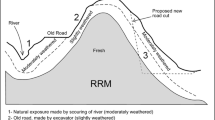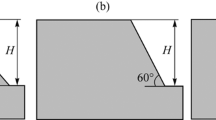Abstract
Rock slope stability is of great concern along highway routes as stability problems on cut slopes may cause fatal events as well as loss of property. In rock slope engineering, stability evaluations are commonly performed by means of analytical or numerical analyses, principally considering the factor of safety concept. As a matter of fact, the probabilistic assessment of slope stability is progressively getting popularity due to difficulties in assigning the most appropriate values to design parameters in analytical or numerical methods. Additionally, the effect of heterogeneities in rock masses and discontinuities on the analysis results is minimized through the probabilistic concept. In this study, slope stability of high and steep sedimentary rock cut slopes along a state highway in Adilcevaz-Bitlis (Turkey) was evaluated on the basis of probabilistic approach using the Slope Stability Probability Classification (SSPC) system. The probabilistic assessment indicates major slope stability problems because of discontinuity controlled and discontinuity orientation independent mass movements. Almost all studied cut slopes suffer from orientation-independent stability problems with very low stability probabilities. Additionally, the probability of planar and toppling failures is significantly high with respect to the SSPC system. The stability problems along the investigated rock slopes were also verified by field reconnaissance. Remedial measures such as slope re-design and reinforcement at the studied locations should be taken to prevent hazardous events along the highway. On the other hand, the probabilistic approach may be a useful tool during rock slope engineering to overcome numerous uncertainties when probabilistic and analytic results are compared.
Similar content being viewed by others
References
Bieniawski ZT (1989) Engineering rock mass classifications. Wiley, New York, USA. p 251.
Büyükutku AG (2003) The reservoir potential of Miocene carbonate rocks in the Askale and Hinis-Mus-Van sub-basins, East Anatolia, Turkey. Journal of Petroleum Geology 26(2): 175–188.
Chen Z (1995) Recent developments in slope stability analysis. In: Proceedings of the 8th International Congress ISRM, Tokyo, Japan. pp. 1041–1048.
Das I, Sahoo S, van Westen C, et al. (2010) Landslide susceptibility assessment using logistic regression and its comparison with a rock mass classification system, along a road section in the northern Himalayas (India). Geomorphology 114: 627–637. DOI: 10.1016/j.geomorph.2009. 09.023
Deere DU, Miller RP (1966) Engineering classification and index properties for intact rock. Technical Report No. AFNLTR-65-116, Air Force Weapons Laboratory, New Mexico.
Demirtasli E, Pisoni C (1965) The geology of Ahlat-Adilcevaz area, North of Lake Van. Bulletin of the Mineral Research and Exploration Institute of Turkey 64: 22–35.
Duzgun HSB, Bhasin RK (2009) Probabilistic stability evaluation of Oppstadhornet rock slope, Norway. Rock Mechanics and Rock Engineering 42: 729–749. DOI: 10.1007/s00603-008-0011-3
Gökçeoglu C, Sönmez H, Ercanoglu M (2000) Discontinuity controlled probabilistic slope failure risk maps of the Altindag (settlement) region in Turkey. Engineering Geology 55: 277–296. DOI: 10.1016/S0013-7952(99)00083-6
Gürocak Z, Alemdag S, Zaman MM (2008) Rock slope stability and excavatability assessment of rocks at the Kapikaya dam site, Turkey. Engineering Geology 96: 17–27. DOI: 10.1016/j.enggeo.2007.08.005
Hack HRGK (1998) Slope stability probability classification, SSPC. 2nd edn. ITC, Enschede, The Netherlands, ISBN 9061641543, p 258.
Hack HRGK, Price D, Rengers N (2003) A new approach to rock slope stability-a probability classification. Bulletin of Engineering Geology and Environment 62: 167–184. DOI: 10.1007/s10064-002-0155-4
Hoek E, Brown ET (1997) Practical estimates of rock mass strength. International Journal of Rock Mechanics 34: 1165–1186. DOI: 10.1016/S1365-1609(97)80069-X
Hoek E, Carranza-Torres CT, Corkum B, (2002) Hoek-Brown failure criterion-2002 edition. In: Proceedings of the 5th North American Rock Mechanics Symposium, Toronto, Canada, Vol 1, pp. 267–273.
Irigaray C, El Hamdouni R, Jimenez-Peralvarez JD, et al. (2012) Spatial stability of slope cuts in rock massifs using GIS technology and probabilistic analysis. Bulletin of Engineering Geology and the Environment 71(3): 569–578. DOI: 10.1007/s10064-011-0414-3
ISRM (International Society for Rock Mechanics) (2007) The complete ISRM suggested methods for rock characterization, testing and monitoring: 1974-2007: Suggested methods prepared by the commission on testing methods. International Society for Rock Mechanics. R. Ulusay and J.A. Hudson (eds.), ISRM Turkish National Group, KozanOfset, Ankara, p. 628.
Karaman K (2013) Kaya sev durayliliginin farkli yöntemlerle degerlendirilmesi (Ünye, Ordu). Journal of Geological Engineering 37(1): 27–47 (In Turkish).
Kentli B, Topal T (2004) Assessment of rock slope stability for a segment of the Ankara–Pozanti motorway, Turkey. Engineering Geology 74: 73–90. DOI: 10.1016/j.enggeo.2004.03.002
Laubscher DH (1990) A geomechanics classification system for rating of rock mass in mine design. Journal of the South African Institute of Mining and Metallurgy 90(10): 257–273
Li XZ, Xu Q (2016) Application of the SSPC method in the stability assessment of highway rock slopes in the Yunnan province of China. Bulletin of Engineering Geology and the Environment 75(2): 551–562. DOI: 10.1007/s10064-015-0792-z
Lindsay P, Anderson J, Bourke F, et al. (2000) Predicting slope stability in open pit gold and coal mines. In: New Zealand Minerals and Mining Conference Proceedings, 29-31 October, 2000, pp. 29–31.
MTA (2000) Geological map of Turkey, 1:25.000-scaled Van K49-a3 sheet.
Park H, West TR (2001) Development of probabilistic approach for rock wedge failure. Engineering Geology 59: 233–251, DOI:10.1016/S0013-7952(00)00076-4
Park JH, West TR, Woo I (2005) Probabilistic analysis of rock slope stability and random properties of discontinuity parameters, Interstate Highway 40, Western North Carolina, USA. Engineering Geology 79: 230–250. DOI: 10.1016/j.enggeo.2005.02.001
Ramly HE, Morgenstern, NR, Cruden DM (2002) Probabilistic slope stability analysis for practice. Canadian Geotechnical Journal 39: 665–683. DOI: 10.1139/t02-034
Rocscience Inc. (1998) Dips v.5.0 -Graphical and statistical analysis of orientation data. Available online at: http://www.rocscience.com, Toronto, Ontario, Canada.
Rocscience Inc. (2002) RocLab v.1.0 -Rock mass strength analysis using the generalized Hoek-Brown Failure Criterion. www.rocscience.com, Toronto, Ontario, Canada.
Rocscience Inc. (2002) Slide v.5.0 -2D limit equilibrium slope stability analysis.Toronto, Ontario, Canada. Available online at: http://www.rocscience.com (Accessed on 19 May 2014)
Romana M, Serón, JB, Montalar E (2003) SMR geomechanics classification: application, experience and validation. In: Proceedings of the international symposium on role of rock mechanics, South African Institute of Mining and Metallurgy, pp. 1–4.
Sonmez H, Ulusay R (2002) A discussion on the Hoek–Brown failure criterion and suggested modifications to the criterion verified by slope stability case studies. Yerbilimleri/Bulletin for Earth Sciences 26: 77–99.
Author information
Authors and Affiliations
Corresponding author
Additional information
http://orcid.org/0000-0002-8750-4054
http://orcid.org/0000-0002-5752-6949
Electronic supplementary material
Rights and permissions
About this article
Cite this article
Canal, A., Akin, M. Assessment of rock slope stability by probabilistic-based Slope Stability Probability Classification method along highway cut slopes in Adilcevaz-Bitlis (Turkey). J. Mt. Sci. 13, 1893–1909 (2016). https://doi.org/10.1007/s11629-016-3954-y
Received:
Revised:
Accepted:
Published:
Issue Date:
DOI: https://doi.org/10.1007/s11629-016-3954-y




